power steering TOYOTA AVALON 2021 Owners Manual (in English)
[x] Cancel search | Manufacturer: TOYOTA, Model Year: 2021, Model line: AVALON, Model: TOYOTA AVALON 2021Pages: 548, PDF Size: 13.4 MB
Page 3 of 548

3
1
8 7 5 4
3
2
9
6
3-1. Key information
Keys .................................. 122
3-2. Opening, closing and
locking the doors
Doors................................. 125
Trunk ................................. 131
Smart key system.............. 135
3-3. Adjusting the seats
Front seats ........................ 142
Rear seats ......................... 144
Driving position
memory ........................... 146
Head restraints .................. 151
3-4. Adjusting the steering
wheel and mirrors
Steering wheel .................. 153
Inside rear view mirror....... 155
Outside rear view
mirrors ............................. 157
3-5. Opening and closing
the windows
Power windows ................. 160
Moon roof .......................... 1644-1. Before driving
Driving the vehicle ............. 170
Cargo and luggage ............ 178
Vehicle load limits .............. 181
Trailer towing ..................... 182
Dinghy towing .................... 183
4-2. Driving procedures
Engine (ignition) switch...... 184
Automatic transmission ..... 189
Turn signal lever ................ 195
Parking brake .................... 196
Brake Hold ......................... 200
4-3. Operating the lights
and wipers
Headlight switch ................ 202
Automatic High Beam ........ 206
Windshield wipers
and washer ...................... 210
4-4. Refueling
Opening the fuel tank
cap................................... 214
3Operation of each
component4Driving
Page 4 of 548

TABLE OF CONTENTS4
4-5. Using the driving
support systems
Toyota Safety Sense P ..... 218
PCS
(Pre-Collision System) .... 226
LDA (Lane Departure Alert
with steering control) ....... 237
Dynamic radar cruise
controlwith full-speed
range ............................... 247
BSM
(Blind Spot Monitor) ........ 260
• BSM function ................ 264
• RCTA function .............. 267
Rear Camera Detection
function (vehicles with
panoramic view
monitor) ........................... 272
Intuitive parking assist ....... 276
Intelligent Clearance
Sonar (ICS) ..................... 284
Driving mode select
switches .......................... 305
Driving assist systems....... 309
4-6. Driving tips
Winter driving tips.............. 3175-1. Using the
air conditioning
system and defogger
Automatic air conditioning
system ............................. 322
Heated steering wheel/
seat heaters/seat
ventilators ........................ 329
5-2. Using the interior lights
Interior lights list................. 332
• Interior light ................... 333
• Personal lights............... 333
• Ambient lights................ 334
5-3. Using the storage
features
List of storage features ...... 335
• Glove box ...................... 336
• Console box .................. 336
• Bottle holders ................ 337
• Cup holders ................... 338
• Auxiliary boxes .............. 339
• Open tray ...................... 340
Trunk features ................... 341
5-4. Other interior features
Other interior features........ 342
• Sun visors ..................... 342
• Vanity mirrors ................ 342
• Power outlet .................. 343
• USB charging ports ....... 344
• Wireless charger ........... 346
• Armrest.......................... 355
• Assist grips .................... 355
• Coat hooks .................... 356
Garage door opener .......... 3575Interior features
Page 85 of 548
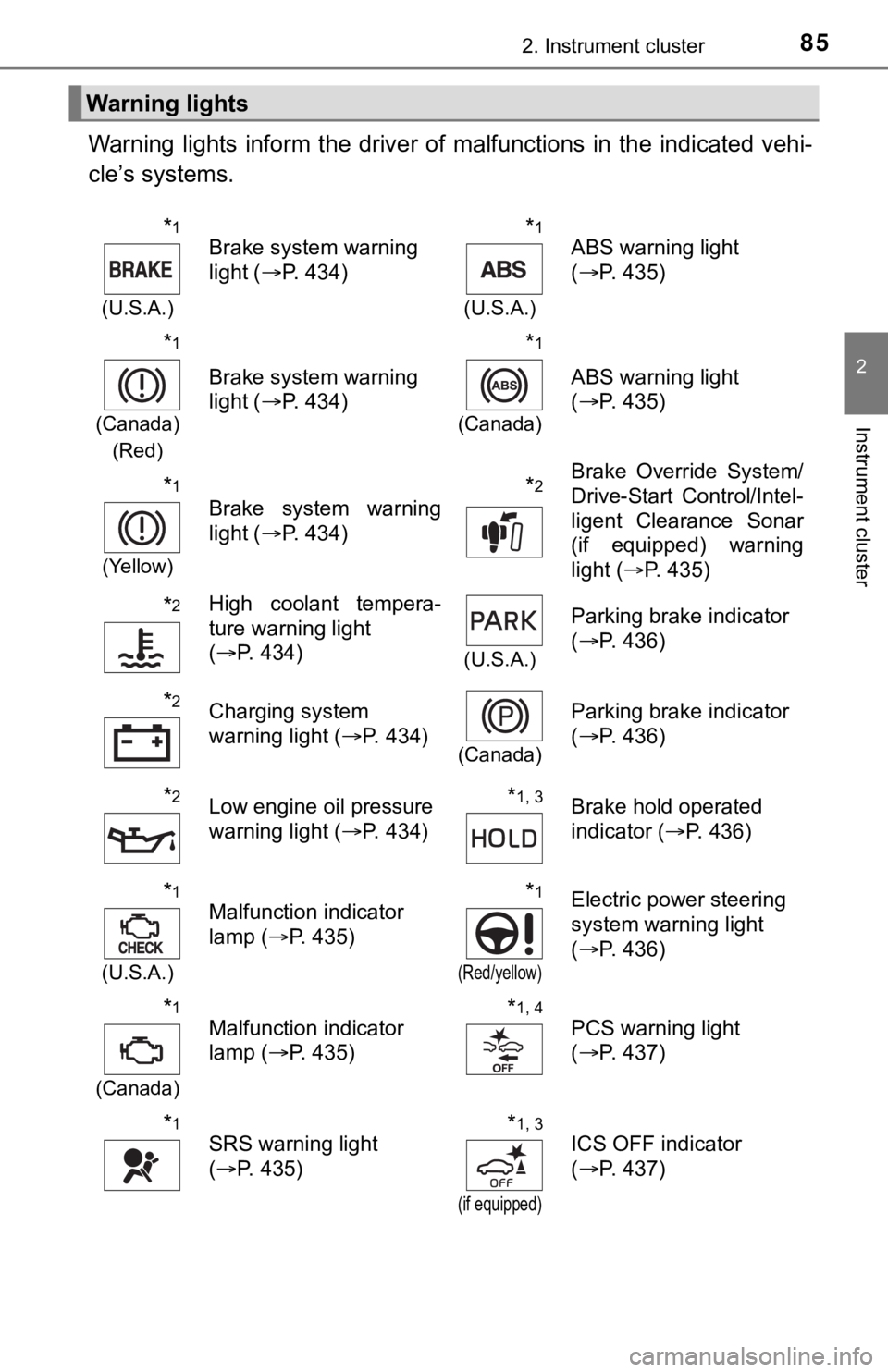
852. Instrument cluster
2
Instrument cluster
Warning lights inform the driver of malfunctions in the indicated vehi-
cle’s systems.
Warning lights
*1
(U.S.A.)
Brake system warning
light (P. 434)*1
(U.S.A.)
ABS warning light
(P. 435)
*1
(Canada)
(Red)
Brake system warning
light (P. 434)
*1
(Canada)
ABS warning light
(P. 435)
*1
(Yellow)
Brake system warning
light (P. 434)*2Brake Override System/
Drive-Start Control/Intel-
ligent Clearance Sonar
(if equipped) warning
light (P. 435)
*2High coolant tempera-
ture warning light
(P. 434)
(U.S.A.)
Parking brake indicator
(P. 436)
*2Charging system
warning light (P. 434)
(Canada)
Parking brake indicator
(P. 436)
*2Low engine oil pressure
warning light (P. 434)*1, 3Brake hold operated
indicator (P. 436)
*1
(U.S.A.)
Malfunction indicator
lamp (P. 435)*1
(Red/yellow)
Electric power steering
system warning light
(P. 436)
*1
(Canada)
Malfunction indicator
lamp (P. 435)*1, 4PCS warning light
(P. 437)
*1SRS warning light
(P. 435)*1, 3
(if equipped)
ICS OFF indicator
(P. 437)
Page 121 of 548

121
3
Operation of
each component
3-1. Key information
Keys .................................. 122
3-2. Opening, closing and
locking the doors
Doors ................................ 125
Trunk ................................. 131
Smart key system ............. 135
3-3. Adjusting the seats
Front seats ........................ 142
Rear seats......................... 144
Driving position
memory ........................... 146
Head restraints.................. 151
3-4. Adjusting the steering
wheel and mirrors
Steering wheel .................. 153
Inside rear view mirror ...... 155
Outside rear view
mirrors ............................. 157
3-5. Opening and closing
the windows
Power windows ................. 160
Moon roof .......................... 164
Page 142 of 548
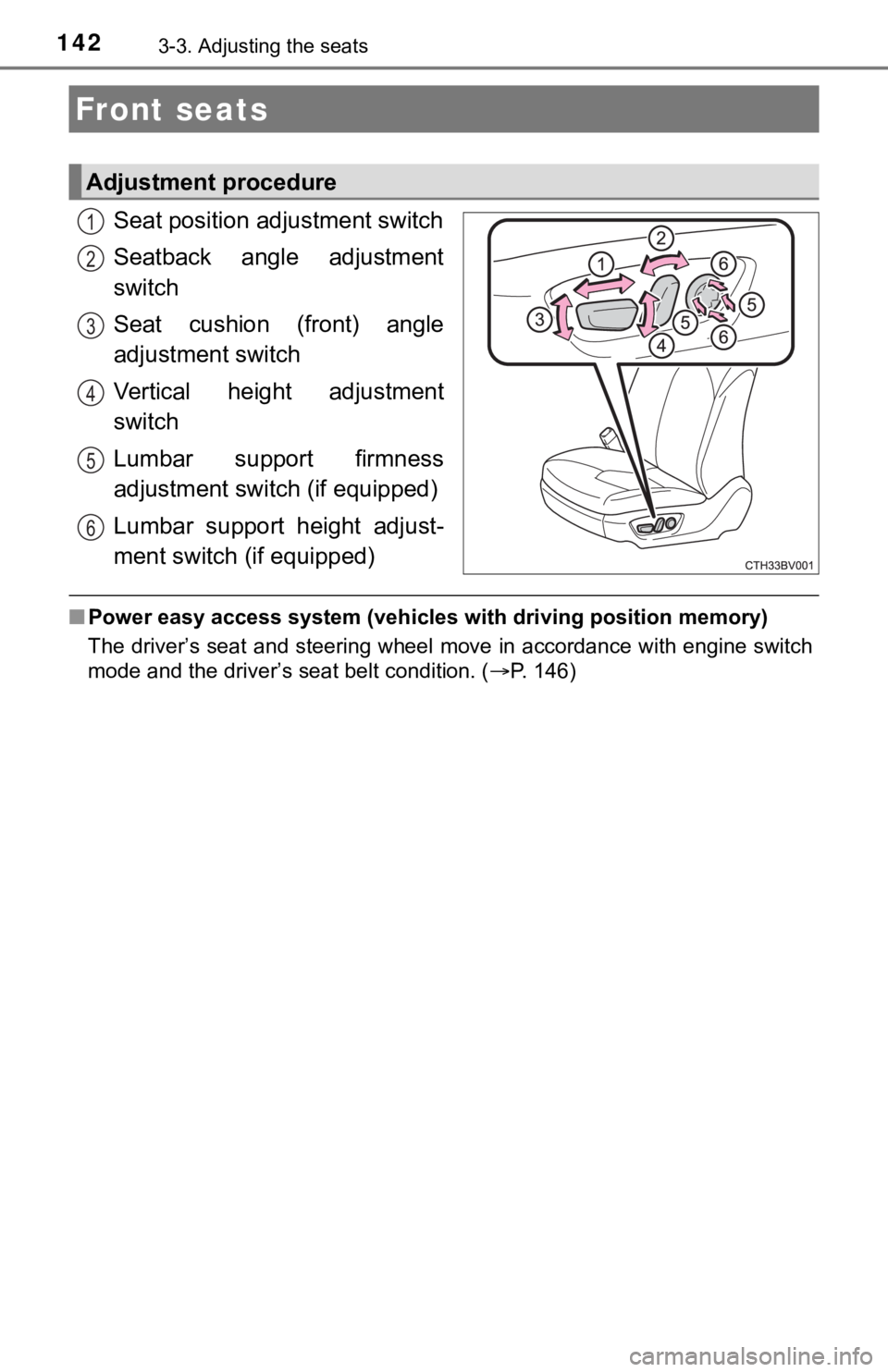
1423-3. Adjusting the seats
Seat position adjustment switch
Seatback angle adjustment
switch
Seat cushion (front) angle
adjustment switch
Vertical height adjustment
switch
Lumbar support firmness
adjustment switch (if equipped)
Lumbar support height adjust-
ment switch (if equipped)
■Power easy access system (vehicles with driving position memory)
The driver’s seat and steering wheel move in accordance with engine switch
mode and the driver’s seat belt condition. (P. 146)
Front seats
Adjustment procedure
1
2
3
4
5
6
Page 146 of 548
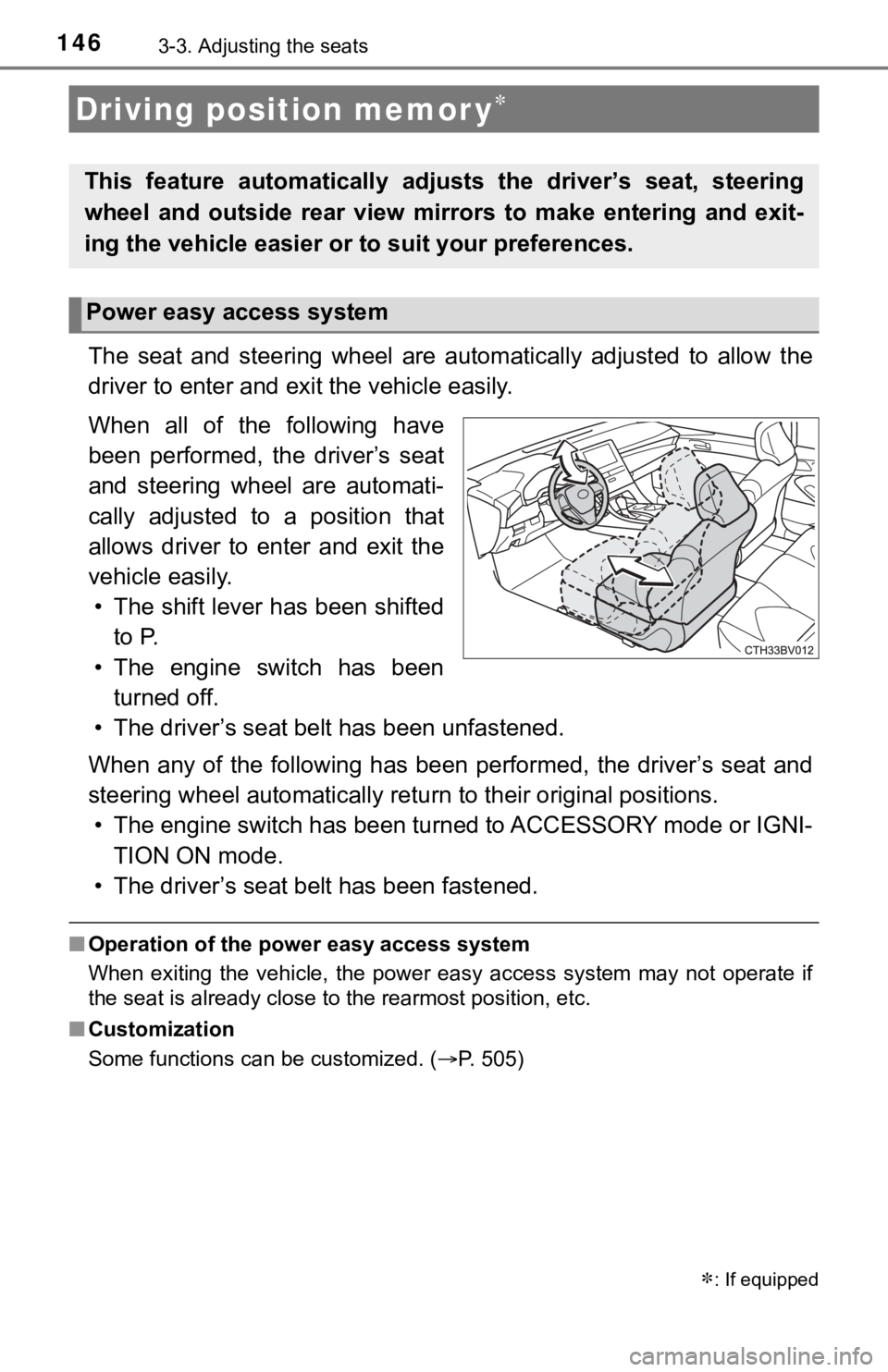
1463-3. Adjusting the seats
The seat and steering wheel are automatically adjusted to allow the
driver to enter and exit the vehicle easily.
When all of the following have
been performed, the driver’s seat
and steering wheel are automati-
cally adjusted to a position that
allows driver to enter and exit the
vehicle easily.
• The shift lever has been shifted
to P.
• The engine switch has been
turned off.
• The driver’s seat belt has been unfastened.
When any of the following has been performed, the driver’s seat and
steering wheel automatically return to their original positions.
• The engine switch has been turned to ACCESSORY mode or IGNI-
TION ON mode.
• The driver’s seat belt has been fastened.
■Operation of the power easy access system
When exiting the vehicle, the power easy access system may not operate if
the seat is already close to the rearmost position, etc.
■Customization
Some functions can be customized. (P. 505)
Driving position memor y
This feature automatically adjusts the driver’s seat, steering
wheel and outside rear view mirrors to make entering and exit-
ing the vehicle easier or to suit your preferences.
: If equipped
Power easy access system
Page 153 of 548
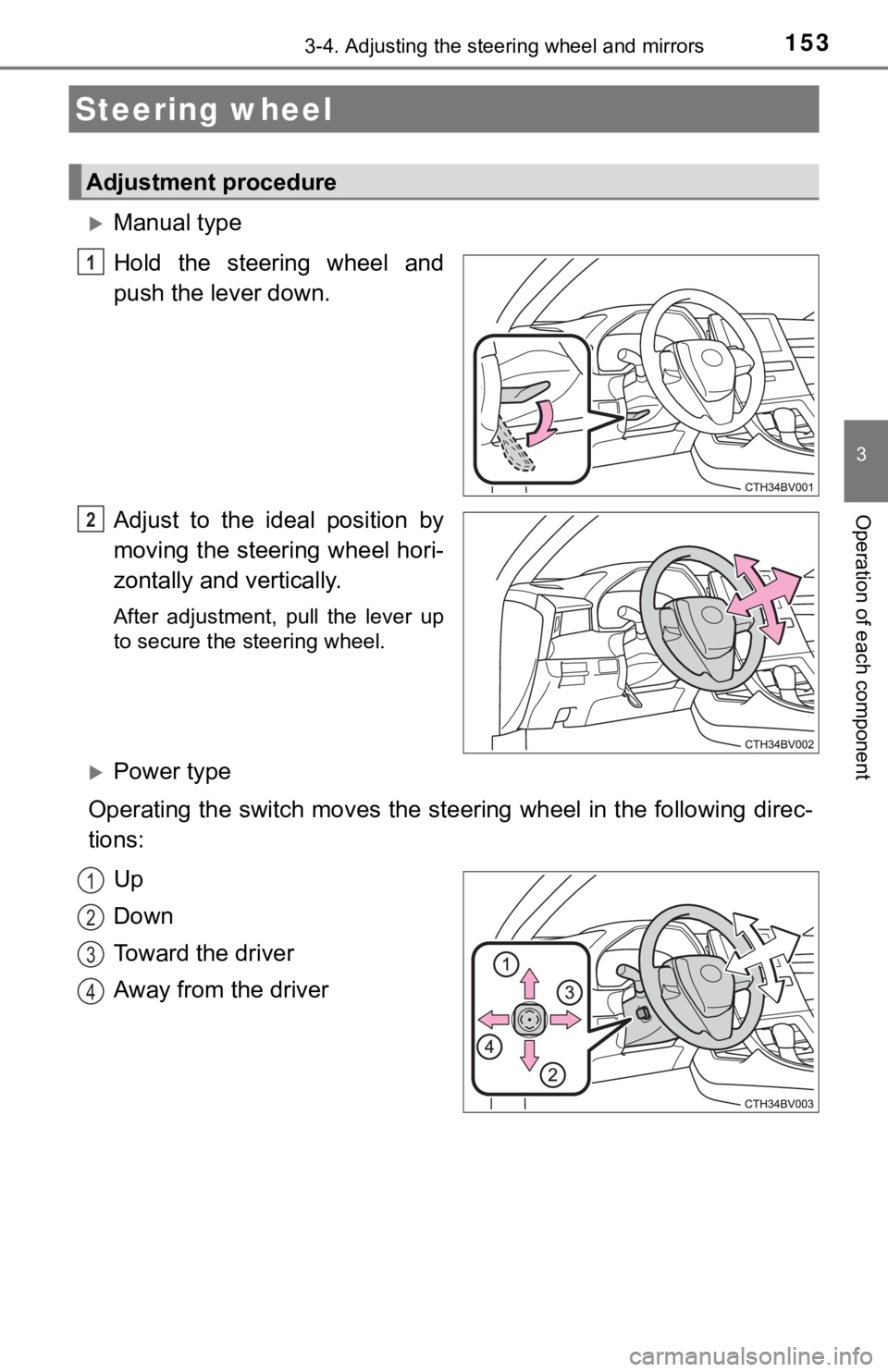
153
3
Operation of each component
3-4. Adjusting the steering wheel and mirrors
Manual type
Hold the steering wheel and
push the lever down.
Adjust to the ideal position by
moving the steering wheel hori-
zontally and vertically.
After adjustment, pull the lever up
to secure the steering wheel.
Power type
Operating the switch moves the steering wheel in the following direc-
tions:
Up
Down
Toward the driver
Away from the driver
Steering wheel
Adjustment procedure
1
2
1
2
3
4
Page 154 of 548
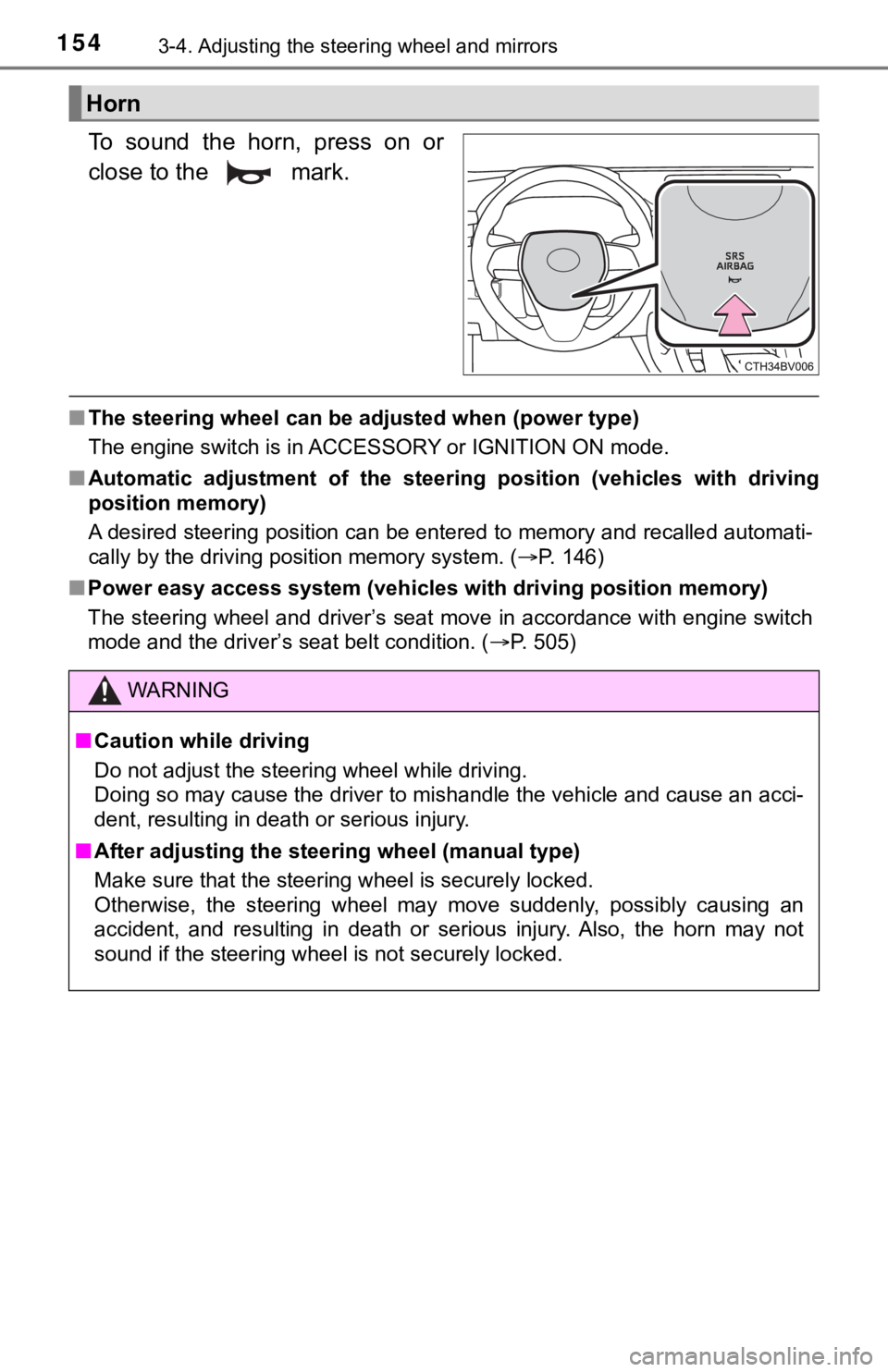
1543-4. Adjusting the steering wheel and mirrors
To sound the horn, press on or
close to the mark.
■The steering wheel can be adjusted when (power type)
The engine switch is in ACCESSORY or IGNITION ON mode.
■Automatic adjustment of the steering position (vehicles with driving
position memory)
A desired steering position can be entered to memory and recalled automati-
cally by the driving position memory system. (P. 146)
■Power easy access system (vehicles with driving position memory)
The steering wheel and driver’s seat move in accordance with engine switch
mode and the driver’s seat belt condition. (P. 505)
Horn
WARNING
■Caution while driving
Do not adjust the steering wheel while driving.
Doing so may cause the driver to mishandle the vehicle and cause an acci-
dent, resulting in death or serious injury.
■After adjusting the steering wheel (manual type)
Make sure that the steering wheel is securely locked.
Otherwise, the steering wheel may move suddenly, possibly causing an
accident, and resulting in death or serious injury. Also, the horn may not
sound if the steering wheel is not securely locked.
Page 173 of 548

1734-1. Before driving
4
Driving
WARNING
Observe the following precautions.
Failure to do so may result in death or serious injury.
■When starting the vehicle
Always keep your foot on the brake pedal while stopped with the engine
running. This prevents the vehicle from creeping.
■When driving the vehicle
●Do not drive if you are unfamiliar with the location of the brake and accel-
erator pedals to avoid depressing the wrong pedal.
• Accidentally depressing the accelerator pedal instead of the brake
pedal will result in sudden acceleration that may lead to an accident.
• When backing up, you may twist your body around, leading to a diffi-
culty in operating the pedals. Make sure to operate the pedals properly.
• Make sure to keep a correct driving posture even when moving the
vehicle only slightly. This allows you to depress the brake and accelera-
tor pedals properly.
• Depress the brake pedal using your right foot. Depressing the brake
pedal using your left foot may delay response in an emergency, result-
ing in an accident.
●Do not drive the vehicle over or stop the vehicle near flammable materials.
The exhaust system and exhaust gases can be extremely hot. These hot
parts may cause a fire if there is any flammable material nearby.
●During normal driving, do not turn off the engine. Turning the engine off
while driving will not cause loss of steering or braking control, but the
power assist to these systems will be lost. This will make it more difficult to
steer and brake, so you should pull over and stop the vehicle as soon as it
is safe to do so.
However, in the event of an emergency, such as if it becomes impossible
to stop the vehicle in the normal way: P. 425
●Use engine braking (downshift) to maintain a safe speed when driving
down a steep hill.
Using the brakes continuously may cause the brakes to overheat and lose
effectiveness. (P. 190)
●Do not adjust the display, the positions of the steering wheel, the seat, or
the inside or outside rear view mirrors while driving.
Doing so may result in a loss of vehicle control.
●Always check that all passengers’ arms, heads or other parts of their body
are not outside the vehicle.
●AWD models: Do not drive the vehicle off-road.
This is not an AWD vehicle designed for off-road driving. Proceed with all
due caution if it becomes unavoidable to drive off-road.
Page 177 of 548

1774-1. Before driving
4
Driving
NOTICE
■When driving the vehicle
●Do not depress the accelerator and brake pedals at the same time during
driving, as this may restrain the engine output.
●Do not use the accelerator pedal or depress the accelerator and brake
pedals at the same time to hold the vehicle on a hill.
■When parking the vehicle
Always set the parking brake and shift the shift lever to P. Failure to do so
may cause the vehicle to move or the vehicle may accelerate suddenly if
the accelerator pedal is accidentally depressed.
■Avoiding damage to vehicle parts
●Do not turn the steering wheel fully in either direction and hold it there for
an extended period of time.
Doing so may damage the power steering motor.
●When driving over bumps in the road, drive as slowly as possible to avoid
damaging the wheels, underside of the vehicle, etc.
■If you get a flat tire while driving
A flat or damaged tire may cause the following situations. Hold the steering
wheel firmly and gradually depress the brake pedal to slow down the vehi-
cle.
●It may be difficult to control your vehicle.
●The vehicle will make abnormal sounds or vibrations.
●The vehicle will lean abnormally.
Information on what to do in case of a flat tire (P. 449)
■When encountering flooded roads
Do not drive on a road that has flooded after heavy rain etc. Doing so may
cause the following serious damage to the vehicle:
●Engine stalling
●Short in electrical components
●Engine damage caused by water immersion
In the event that you drive on a flooded road and the vehicle is flooded, be
sure to have your Toyota dealer check the following:
●Brake function
●Changes in quantity and quality of oil and fluid used for the engine, tran-
saxle, transfer (AWD models), rear differential (AWD models), etc.
●Lubricant condition for the propeller shaft (AWD models), bearings and
suspension joints (where possible), and the function of all joints, bearings,
etc.